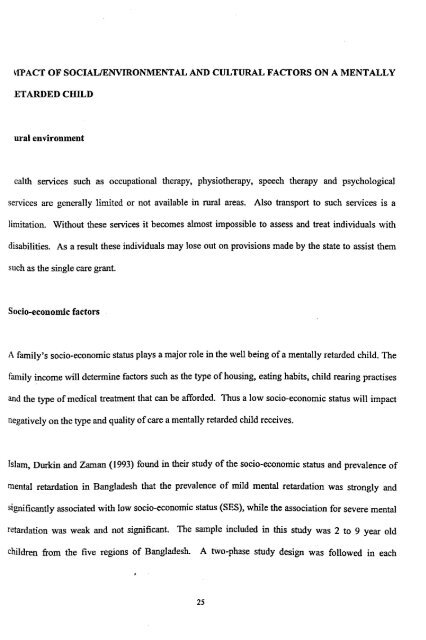attitudes of parents towards their mentally retarded children: a rural ...
attitudes of parents towards their mentally retarded children: a rural ...
attitudes of parents towards their mentally retarded children: a rural ...
Create successful ePaper yourself
Turn your PDF publications into a flip-book with our unique Google optimized e-Paper software.
I1PACT OF SOCIALlENVIRONMENTAL AND CULTURAL FACTORS ON A MENTALLY<br />
ETARDED CHILD<br />
uralenvironDlent<br />
ealth sel"Vlces such as occupational therapy, physiotherapy, speech therapy and psychological<br />
services are generally limited or not available in rura1 areas. Also transport to such services is a<br />
limitation. Without these services it becomes almost impossible to assess and treat individuals with<br />
disabilities. As a result these individuals may lose out on provisions made by the state to assist them<br />
such as the single care grant.<br />
Socio-economic factors<br />
A family's socio-economic status plays a major role in the well being <strong>of</strong>a <strong>mentally</strong> <strong>retarded</strong> child. The<br />
family income will determine factors such as the type <strong>of</strong>housing, eating habits, child rearing practises<br />
and the type <strong>of</strong>medical treatment that can be afforded. Thus a low socio-economic status will impact<br />
negatively on the type and quality <strong>of</strong>care a <strong>mentally</strong> <strong>retarded</strong> child receives.<br />
Islam, Durkin and Zaman (1993) found in <strong>their</strong> study <strong>of</strong>the socio-economic status and prevalence <strong>of</strong><br />
mental retardation in Bangladesh that the prevalence <strong>of</strong> mild mental retardation was strongly and<br />
significantly associated with low socio-economic status (8E8), while the association for severe mental<br />
retardation was weak and not significant. The sample included in this study was 2 to 9 year old<br />
<strong>children</strong> from the five regions <strong>of</strong> Bangladesh. A two-phase study design was followed in each<br />
25
















